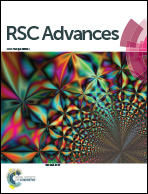Influence of matrix and bulk behaviour of an injectable hydrogel on the survival of encapsulated cardiac cells
Abstract
Cytocompatibility, suitable porosity, higher equilibrium water content and tissue like elasticity are the demanding criteria required to design a hydrogel for cell encapsulation and delivery. Here a mechanically stable cell supporting synthetic hydrogel was fabricated from poly(propylene fumarate-co-ethylene glycol)/PEGDA by redox initiating polymerisation for cell encapsulation. A hydrogel prepared with 93.5% poly(propylene fumarate-co-ethylene glycol) and 6.5% PEGDA acquired matrix and bulk characteristics of equilibrium water content (EWC) 84.45 ± 0.80%, freezable water content 67.93%, Young modulus 212.2 ± 0.02 kPa and pore diameter 88.64 ± 18.96 μm. This hydrogel with higher free water content, favourable pore dimensions and mechanical strength was used to encapsulate cardiomyoblasts. The encapsulated cardiomyoblasts were showing increasing viability from 3–30 days with viable green fluorescence. The matrix and bulk characteristics of the hydrogel are favourable and elicited uniform, green fluorescing, live cardiomyoblasts (H9c2) inside with 150% cell viability (MTT assay) and uniform ECM protein distribution after 30 days. The slow in vitro degradation of the hydrogel in physiological-like conditions is favourable for the delivery and retention of the encapsulated cells at the injection site.


 Please wait while we load your content...
Please wait while we load your content...